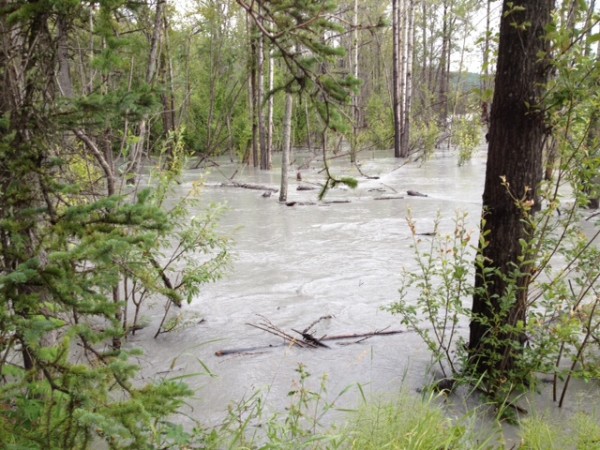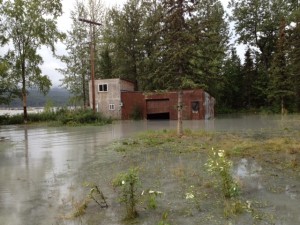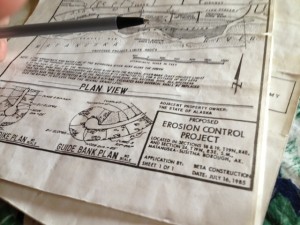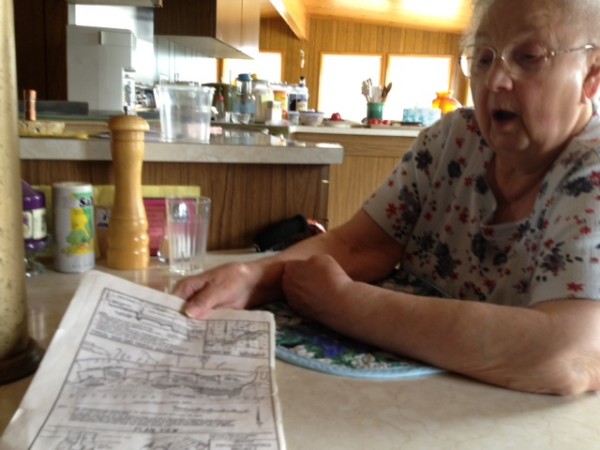The dramatic surge of the Matanuska River during the past few days has pushed families from some homes and is continuing to threaten others. Although a few remaining homeowners are in a wait and see mode, one venerable homesteading couple says, they won’t budge. Meanwhile, down the road, water pushes up against the back deck of a little yellow house. The woman inside won’t talk to a reporter, but she is obviously planning to move her things into a trailer waiting at the front door.

Department of Transportation trucks are scattered along the Glenn Highway North of Sutton, while surveyors pull equipment out to the roadside and inspectors walk the right of way. Late Monday, DOT agreed to send in emergency crews to the area, to start immediate work to protect the Glenn from the spreading waters of the Matanuska River.

Three homes have been abandoned, one has tumbled in, and the waters have reached the back porches of three others.
Mike Pearson lives in a barn style green house close to the highway. But the blue grey water is puddling up in his back yard. I wade across to where he stands looking toward the river.
“You’re not evacuating, I take it?”
“No, not yet. But my four neighbors have just been devastated.”

Pearson says he’s hanging tough for a while, at least. He looks at the water rushing through trees on the property, and points to where the river bank used to be.
“You can see how the pressure is pushing the water up. That’s the river water behind us, right here. Look how far down the river is there. So you can see the amount of pressure that is being pushed into this.”
“Have you ever seen anything like this before?”
“Not this bad. I’ve seen a little water, seen the river come up, but nothing this high.”
Pearson has lived on his property for 35 years. He says the braided river is looking for a natural place to go, and glacial melt is feeding the waters.

Pearson says when he moved in, his house was about a mile from the river, and that erosion has slowly eaten the land away. He blames both Mother Nature and the dykes that the Matanuska Susitna Borough built in the river years ago to try to control its flow. He says he’s still got twenty feet of ground left, and that give him time to think about it.
Further up the highway, Ed Musial ,92, and wife Val, 88, are calmly eating breakfast when I knock on the door. Their well kept home looks high and dry from the road, but on closer inspection, there is very little dry ground between their back door and the edge of the bank.
They have lived in the area since the nineteen fifties, and in the home they built in 1982 since then. They invite me in. “I’ve still got three feet of land, so I’m not going anywhere,” Val says.
“Tell me, what your plan is, are you going to stay here?” I ask.
“We plan to die here,we built this house.” Val answers.
“We are not going no place.” Ed adds.
“We are going to die here.” Val asserts.
“How much land do think is between that door and the cliff?”
“Three feet.” Val says again.
“So you still have three feet of land? Doesn’t that bother you?”
“No. This house ain’t going nowhere.” Ed is confident the house will stand.
Ed Musial used to work construction. He says his concrete block basement is so heavy the river won’t budge it. He shows me the immaculately kept basement, blue cinder block walls and a furnace room that’s tidier than most people’s living rooms. But the Musials, too, say dykes put in by the Borough in the nineteen eighties could have caused the current problem. Val says the river’s rampage is nothing new.
“It’s been happening for years,” she says.
“Since ’86.” Ed adds.
“Ever since they blew out those dykes, the river has been coming in and coming in and coming in. The last couple of days, those people down there (at mile 64) really got it. But we have been fighting this river since ’86.”
“You don’t have a whole lot to fight from. I mean, I can see the river through the back door,” I say.
“Well, we used to, we used to.” Val says.
“How far was it?”
” I used to have a fifty foot close line in the back yard, and then we had a one lane road back there, and then there was an embankment, and then the yellow creek, the salmon spawning stream, then there was woods and the river was way the hell over there.”
Val says, they will hang on to the three feet of land between their house and the river. Neighbors have offered them shelter. They have daughter in Eagle River. But they plan to tough it out.
Borough officials announced today that those affected by the river erosion still have time to file for a federal buyout program that could pay them for their property.
APTI Reporter-Producer Ellen Lockyer started her radio career in the late 1980s, after a stint at bush Alaska weekly newspapers, the Copper Valley Views and the Cordova Times. When the Exxon Valdez ran aground in Prince William Sound, Valdez Public Radio station KCHU needed a reporter, and Ellen picked up the microphone.
Since then, she has literally traveled the length of the state, from Attu to Eagle and from Barrow to Juneau, covering Alaska stories on the ground for the AK show, Alaska News Nightly, the Alaska Morning News and for Anchorage public radio station, KSKA
elockyer (at) alaskapublic (dot) org | 907.550.8446 | About Ellen




